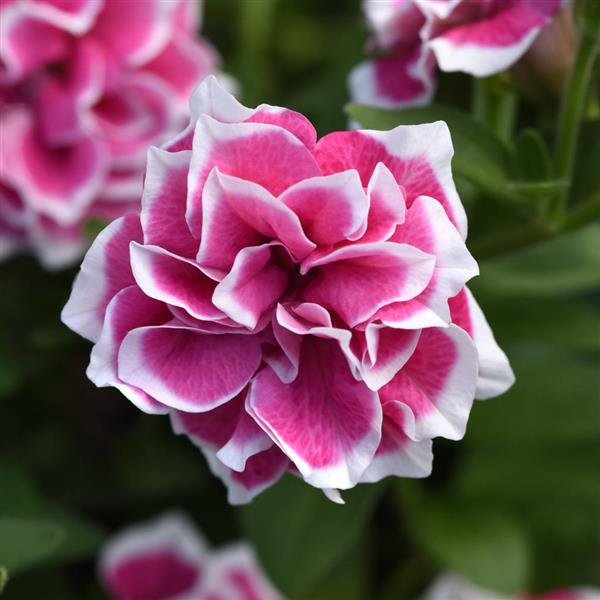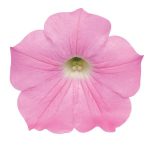Petunia, Double Pink Diamond
$8.99
Discount per quantity
| Quantity | 3 - 8 | 9 - 14 | 15+ |
|---|---|---|---|
| Price | $8.72 | $8.45 | $8.09 |
| % Discount | 3% | 6% | 10% |
Description
Double Pink Diamond Petunia: A Sparkling Jewel for Your Garden
Welcome to the World of Double Pink Diamond
We all love moments that make us stop and smile. A perfect sunrise. The first bite of a sweet peach. And, of course, a flower that looks like it was spun from cotton candy and diamonds at the same time. Double Pink Diamond Petunia gives us that feeling every single day it blooms.
In other words, this petunia turns an ordinary pot or patch of soil into a front-row seat at nature’s glitter show. Its fully double, rose-pink petals stack in tight layers, forming soft ruffles that catch the light and bounce it back to us. Each blossom looks like a tiny pinwheel sewn from velvet and silk. But most of all, the plant keeps those blooms coming from the first warm weeks of spring until a crisp fall breeze finally says, “Rest now.”
Instead of acting shy or delicate, Double Pink Diamond grows with gentle strength. It spreads outward but not wildly, fills hanging baskets yet never drags to the ground, and partners with other colors without losing its own spotlight. After more than a season with it, many gardeners say, “Why did I wait so long?”
A Bloom Like No Other
What Makes It Special
- Fully double blooms – Each flower carries extra petals, so it looks like a miniature peony or camellia rather than a single-layer petunia.
- Pure candy-pink color – The shade is bold enough to pop across the yard while still matching softer pastel partners.
- Self-cleaning habit – Spent blooms hide away, so we spend less time deadheading and more time enjoying.
- Compact, mounded form – About 8–12 inches tall and 14–18 inches wide, perfect for baskets, window boxes, and garden borders.
- Extended bloom season – With the right care, flowers continue from late April or early May through the first light frost.
Origins and Breeding
Plant breeders wanted a petunia that mixed the tidy growth of modern hybrids with the lush look of old-fashioned doubles. By crossing a deep rose double type with a compact trailing line, they created the Double Diamond series. Double Pink Diamond quickly became the crown jewel. Today, tissue-culture propagation keeps each new plant true to form, so we get a reliable star in every pot.
Portrait of a Star
Color Play and Texture
When the first buds unfurl, petals overlap in tight folds. As they mature, the layers swirl outward, forming a soft dome. In bright morning sun the blooms look almost neon; under evening light they soften to blush. A faint silver sheen dusts the petal edges, giving that “diamond” sparkle that inspired the name.
Touch a petal and you feel a fine suede. That texture holds gentle raindrops like crystal beads. Bees visit, even though double blooms usually hide nectar. They find tiny pathways between petals, and the plant’s light fragrance guides them home.
Growth Habit and Shape
Double Pink Diamond starts as a neat mound. Stems branch freely and quickly, filling gaps without growing lanky. In a container, side shoots drape slightly over the rim, creating a waterfall of pink ruffles. In a bed, plants knit together, forming a low cushion that suppresses weeds. We can trim lightly for sharper edges or let them flow for a relaxed cottage look.
Designing with Double Pink Diamond
Containers That Shine
- Hanging Baskets – Pair with silver dichondra for extra sparkle. The petunia spills in soft waves while the trailing silver vines add shimmer.
- Window Boxes – Match with white alyssum and upright blue lobelia. We get a “cotton candy and sky” palette that draws joyful eyes from the street.
- Patio Pots – Place one plant at the center and circle it with chartreuse sweet potato vine. The bright leaves frame the pink blooms like a jewel in a ring.
In the Landscape
Line a garden path with staggered clusters. The mounded shape guides the eye forward, and the endless flowers invite strolling guests to pause and admire. Around taller perennials, Double Pink Diamond acts as living mulch, hiding bare soil and keeping roots cool.
Companion Plants
Color echoes matter. Try:
- Lavender or Catmint – Cool purple balances warm pink.
- Dusty Miller – Silvery leaves highlight the petal glow.
- Soft Yellow Marigold – Adds sunny warmth without clashing.
Plant health partners matter too. Herbs like basil repel some pests and look charming nestled nearby.
How to Care for Your Living Jewel
Light and Location
Double Pink Diamond loves sun. Give it six hours or more of direct light. In scorching midsummer regions, a dash of afternoon shade keeps blooms from bleaching. Place baskets where morning sun floods in, and the plant rewards us with vivid color all day.
Soil Preparation
Petunias appreciate loose, well-drained soil rich in organic matter. Before planting in beds, mix in finished compost. For containers, choose a high-quality potting mix plus a handful of slow-release fertilizer pellets. Avoid garden soil in pots; it compacts and blocks air pockets.
Watering Wisdom
Think even moisture, not soggy shoes. Water when the top inch of mix feels dry. In hot weather, baskets may need daily drinks. Water early so leaves dry before nightfall, lowering disease risk. Instead of splashing petals, aim at the base. A light mulch on garden plants evens out moisture swings.
Feeding for Endless Blooms
Flowers are energy-hungry. Feed with a balanced liquid fertilizer every two weeks, beginning two weeks after planting. Many gardeners choose a bloom-booster formula higher in phosphorus during midsummer. In containers, refresh feeding weekly because nutrients wash out faster.
Pinching and Pruning
Early pinch, many buds. When shoots reach 4–5 inches tall, pinch the tip of each stem. New side shoots appear, doubling bloom potential. Later, if plants grow leggy, shear back by one-third. Water well, add fertilizer, and within ten days fresh buds burst open.
Pest Patrol and Disease Defense
- Aphids – Blast off with a firm shower or apply insecticidal soap.
- Budworm caterpillar – Look for chewed buds. Treat with Bt or hand-pick at dusk.
- Powdery mildew – Promote airflow, avoid overhead watering, and apply a preventive fungicide if local outbreaks happen.
Healthy plants resist trouble. Keep stress low by watering on time and removing faded blooms so energy goes into new growth.
Overwintering Tips
In cold zones, petunias act as an annual. You can, however, take cuttings in late summer. Root them in moist mix indoors under bright light. Grow on a sunny windowsill all winter, pinching lightly. By spring, you have fresh baby plants ready for outdoor life.
Beyond the Basics: Creative Uses
Pollinator Appeal
We think doubles are only for show, but Double Pink Diamond breaks the rule. Bees, hoverflies, and even brave hummingbirds investigate its fruity scent. Plant near herbs and veggies to raise pollination rates.
Edging and Ground Covers
Need a tidy, colorful edge? Lay plants 12 inches apart along a walkway. They knit quickly, forming a soft ribbon of pink. Unlike taller annuals, they stay under a foot tall, so borders look groomed yet relaxed.
DIY Gifts and Table Décor
Clip a few stems and float blooms in shallow bowls for an instant party centerpiece. Or pot one plant in a vintage teacup, top with moss, and tie a ribbon for a heartfelt gift. We can even press petals between pages to craft greeting cards that keep summertime color alive all year.
Common Questions Answered
Will heavy rain ruin the flowers?
The double petals might hold raindrops, but after showers they dry quickly. Shake baskets gently to release water, and blooms perk up again.
Do I need to deadhead?
Technically no. Plants drop old blooms on their own. But a quick weekly clean-up keeps things extra neat and channels energy into fresh buds.
Can I grow Double Pink Diamond from seed?
Seeds are rare and unpredictable. Buying transplants or rooting cuttings ensures true color and form.
Is it safe around pets?
Petunias are generally non-toxic to dogs and cats. Still, discourage chewing to protect both plant and pet.
How long will the flowers last indoors?
Cut blooms last two to three days in water. For longer displays, keep plants in decorative pots near bright windows.
Petunia Care Calendar at a Glance
| Month | Task | Tip |
|---|---|---|
| March | Start cuttings indoors | Provide bright light and bottom warmth |
| April | Harden off transplants | Gradually introduce outdoor sun |
| May | Plant outdoors after frost | Mix compost and slow-release feed |
| June | First liquid fertilizer | Pinch tips for bushier growth |
| July | Watch watering daily | Mulch garden beds to conserve moisture |
| August | Light shear if leggy | Boost with bloom fertilizer |
| September | Enjoy peak flush | Keep feeding every two weeks |
| October | Protect from early frost | Move baskets to a sheltered porch |
| November | Take last cuttings | Compost spent garden plants |
From Our Garden to Yours
Double Pink Diamond Petunia invites us to slow down, breathe deep, and soak in simple beauty. It teaches that luxury can be easy, that care routines can feel like small daily celebrations, and that a single plant can turn a space into a haven. When we tuck a few of these jeweled blooms into pots, boxes, or borders, we do more than decorate. We set the stage for morning coffee smiles, evening firefly watching, and weekend gatherings wrapped in pink sparkle.
So let’s grab our trowels, share cuttings with friends, and watch together as this dazzling petunia turns sunshine, soil, and a bit of love into living art.
Let Your Garden Sparkle
Additional information
| Weight | N/A |
|---|---|
| Options | Starter Plug – 3 count, 4 in. (16.9 fl. oz.) Pot |





